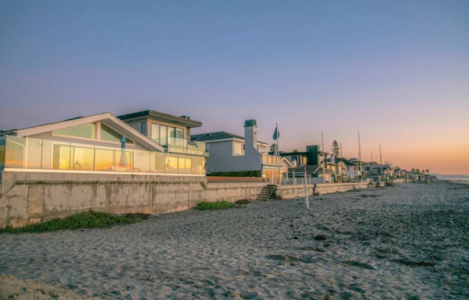Is Your Favourite Aussie Beach Town About to Disappear Forever? See the Shocking Date Locals Have to Leave
By
Gian T
- Replies 0
Imagine waking up to the sound of waves crashing just metres from your doorstep—only to realise those waves are inching closer every year, threatening to swallow your home whole. For the residents of Pelican Point, a picturesque beachside town in South Australia, this isn’t just a distant worry—it’s a looming reality.
A Town on the Brink
Pelican Point, nestled along the windswept coastline with Bungaloo Bay in the foreground, has long been a haven for those seeking a slice of coastal paradise. But now, the very ocean that draws people in is threatening to erase the town from the map. According to recent reports, there’s a 50 per cent chance that Pelican Point could be wiped out by the year 2100. That’s not just a line in the sand—it’s a ticking clock for the community.
Locals Take Matters Into Their Own Hands
Faced with the threat of losing their homes, locals haven’t sat idly by. For the past three decades, residents have been building makeshift break-walls on Crown Land, hoping to hold back the relentless march of the sea. Adrian Ferguson, a long-time resident, shared his experience: ‘The last shack to our right was done just before the recent storms. Last year, they had stones hitting their windows and the waves were hitting the windows. This year it’s just seaweed.’ For now, these break-walls seem to be working, but everyone knows it’s a temporary fix.
Interestingly, not everyone is convinced by the dire predictions. ‘I don’t think the sea is rising… you talk to the old guys here, they’ve seen this before,’ Ferguson said, echoing a sentiment shared by many in the community. For some, the motivation to build these barriers is as much about protecting their investments—some homes are valued at up to $700,000—as it is about saving their slice of paradise.
Council Caught Between Science and Sentiment
The District Council of Grant, which oversees Pelican Point, initially opposed the residents’ DIY sea walls, even taking legal action. But as the threat became more apparent, the council changed its stance in 2017 and began working with locals on a ‘coastal adaptation’ strategy. The council’s draft action plan doesn’t mince words: ‘The town’s low elevation makes it highly vulnerable to inundation during storm events, which is likely to cause substantial damage to both public and private assets.’
The council is now collaborating with the community to identify hazards and risks for each coastal township by 2050 and up to 2100, evaluating options to adapt and protect these communities for the future. It’s a race against time, and the stakes couldn’t be higher.
Divided Opinions and Difficult Choices
A recent community survey revealed a town divided. Nearly all residents support making changes to their homes as part of the adaptation strategy, but only a third are willing to consider moving their properties altogether. Some demand immediate action, fearing irreversible damage, while others remain sceptical, viewing the changes as part of a natural cycle rather than a climate crisis.
This scepticism isn’t unique to Pelican Point. Across Australia, many coastal communities are grappling with similar dilemmas—balancing scientific modelling and long-term projections with lived experience and local knowledge. For some, the threat feels exaggerated; for others, it’s all too real.
The Bigger Picture: Coastal Erosion in Australia
Pelican Point’s plight is a microcosm of a much larger issue. Australia’s coastline stretches for over 25,000 kilometres, and many towns face similar threats from rising sea levels, storm surges, and coastal erosion. From the Gold Coast to the Great Ocean Road, communities are being forced to confront uncomfortable questions: How do we protect our homes? When do we retreat? And who pays the price?
The cost of inaction can be staggering—not just in terms of property values, but also in the loss of community, heritage, and the unique way of life that defines so many of our beachside towns.
What Can Be Done?
Experts suggest a mix of solutions: building more robust sea defences, restoring natural barriers like dunes and mangroves, and, in some cases, relocating entire communities. None of these options are easy, and all come with significant financial, emotional, and environmental costs.
For now, Pelican Point’s residents are doing what they can—stacking rocks, reinforcing walls, and hoping for the best. But as the council’s modelling shows, the clock is ticking.
Have Your Say
Have you or someone you know been affected by coastal erosion or rising sea levels? Do you think the threat is real, or is it just another cycle of nature? Would you be willing to move if your home were at risk, or would you fight to stay put? We’d love to hear your thoughts and stories—share them in the comments below and join the conversation with your fellow Seniors Discount Club members.
 Let’s keep the discussion going—after all, the future of our beloved beach towns might just depend on it.
Let’s keep the discussion going—after all, the future of our beloved beach towns might just depend on it.
Read more: Shocking beachside ordeal: What happened to this TV presenter could happen to you!
A Town on the Brink
Pelican Point, nestled along the windswept coastline with Bungaloo Bay in the foreground, has long been a haven for those seeking a slice of coastal paradise. But now, the very ocean that draws people in is threatening to erase the town from the map. According to recent reports, there’s a 50 per cent chance that Pelican Point could be wiped out by the year 2100. That’s not just a line in the sand—it’s a ticking clock for the community.
Locals Take Matters Into Their Own Hands
Faced with the threat of losing their homes, locals haven’t sat idly by. For the past three decades, residents have been building makeshift break-walls on Crown Land, hoping to hold back the relentless march of the sea. Adrian Ferguson, a long-time resident, shared his experience: ‘The last shack to our right was done just before the recent storms. Last year, they had stones hitting their windows and the waves were hitting the windows. This year it’s just seaweed.’ For now, these break-walls seem to be working, but everyone knows it’s a temporary fix.
Interestingly, not everyone is convinced by the dire predictions. ‘I don’t think the sea is rising… you talk to the old guys here, they’ve seen this before,’ Ferguson said, echoing a sentiment shared by many in the community. For some, the motivation to build these barriers is as much about protecting their investments—some homes are valued at up to $700,000—as it is about saving their slice of paradise.
Council Caught Between Science and Sentiment
The District Council of Grant, which oversees Pelican Point, initially opposed the residents’ DIY sea walls, even taking legal action. But as the threat became more apparent, the council changed its stance in 2017 and began working with locals on a ‘coastal adaptation’ strategy. The council’s draft action plan doesn’t mince words: ‘The town’s low elevation makes it highly vulnerable to inundation during storm events, which is likely to cause substantial damage to both public and private assets.’
The council is now collaborating with the community to identify hazards and risks for each coastal township by 2050 and up to 2100, evaluating options to adapt and protect these communities for the future. It’s a race against time, and the stakes couldn’t be higher.
Divided Opinions and Difficult Choices
A recent community survey revealed a town divided. Nearly all residents support making changes to their homes as part of the adaptation strategy, but only a third are willing to consider moving their properties altogether. Some demand immediate action, fearing irreversible damage, while others remain sceptical, viewing the changes as part of a natural cycle rather than a climate crisis.
This scepticism isn’t unique to Pelican Point. Across Australia, many coastal communities are grappling with similar dilemmas—balancing scientific modelling and long-term projections with lived experience and local knowledge. For some, the threat feels exaggerated; for others, it’s all too real.
The Bigger Picture: Coastal Erosion in Australia
Pelican Point’s plight is a microcosm of a much larger issue. Australia’s coastline stretches for over 25,000 kilometres, and many towns face similar threats from rising sea levels, storm surges, and coastal erosion. From the Gold Coast to the Great Ocean Road, communities are being forced to confront uncomfortable questions: How do we protect our homes? When do we retreat? And who pays the price?
The cost of inaction can be staggering—not just in terms of property values, but also in the loss of community, heritage, and the unique way of life that defines so many of our beachside towns.
What Can Be Done?
Experts suggest a mix of solutions: building more robust sea defences, restoring natural barriers like dunes and mangroves, and, in some cases, relocating entire communities. None of these options are easy, and all come with significant financial, emotional, and environmental costs.
For now, Pelican Point’s residents are doing what they can—stacking rocks, reinforcing walls, and hoping for the best. But as the council’s modelling shows, the clock is ticking.
Have Your Say
Have you or someone you know been affected by coastal erosion or rising sea levels? Do you think the threat is real, or is it just another cycle of nature? Would you be willing to move if your home were at risk, or would you fight to stay put? We’d love to hear your thoughts and stories—share them in the comments below and join the conversation with your fellow Seniors Discount Club members.
Key Takeaways
- Residents of Pelican Point in South Australia are worried their town could be lost to the ocean by 2100 due to severe coastal erosion, with council modelling predicting significant land loss over the next 75 years.
- Locals have built makeshift break-walls on Crown Land over the past three decades to try and protect their homes, some of which are valued at up to $700,000.
- The District Council of Grant has now partnered with the community on a coastal adaptation plan to identify risks and options for protecting townships against rising sea levels and inundation.
- While almost all residents support making changes to adapt to erosion, only a third are in favour of moving their homes, and some remain sceptical of climate modelling and the need for drastic measures.
Read more: Shocking beachside ordeal: What happened to this TV presenter could happen to you!








